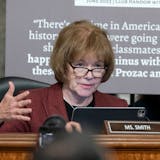Aviation buff John Zimmerman was at a weekly gathering of neighbors Friday night when he noticed something peculiar: a small plane circling a route overhead that didn't make sense to him.
It was dark, so a sightseeing flight didn't make sense, and when Zimmerman pulled up more information on an aviation phone app he routinely checks, he had immediate concerns.
The plane's flight path, recorded by the website flightradar24.com, would eventually show that it circled downtown Minneapolis, the Mall of America and Southdale Center at low altitude for hours starting at 10:30 p.m., slipping off radar just after 3 a.m.
"I thought, 'Holy crap,' " said Zimmerman.
Bearing the call sign N361DB, the plane is one of three Cessna 182T Skylanes registered to LCB Leasing of Bristow, Va., according to FAA records. The Virginia secretary of state has no record of an LCB Leasing. Virtually no other information could be learned about the company.
Zimmerman's curiosity might have ended there if it weren't for something he heard from his aviation network recently: A plane registered to NG Research — also located in Bristow — that circled Baltimore for hours after recent violent protests there was in fact an FBI plane that's part of a widespread but little known surveillance program, according to a report by the Washington Post.
Similar flights have since been spotted near Chicago, Boston and in California, according to the American Civil Liberties Union. The ACLU has filed several Freedom of Information Act requests for more information.
It believes the planes use cameras and infrared imaging technology to photograph people and vehicles in a broad swath of the city; technology to sweep up cellphone data from a plane also exists, but it's not clear if the FBI flights use it.


